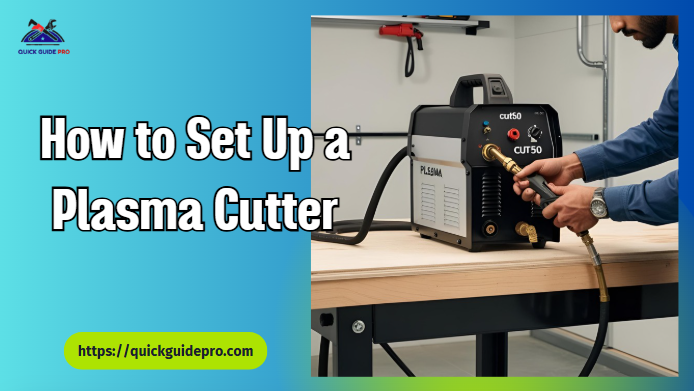
Setting up a plasma cutter is simple, but it must be done correctly to ensure safety and its best performance.
⚠️Plasma cutting can be dangerous if you set up the unit incorrectly. So, it’s important to understand how to safely set it up.
This guide will walk you through how to set up a plasma cutter so that it’s ready for use when needed!
Table of Contents
How to Set Up a Plasma Cutter
Before going through the steps, there are some points that you should learn.
🧠 Things to bear in mind before setting up a plasma cutter:
Firstly, you should know about your plasma cutter‘s fundamental components. It’ll also be great if you know its recommended setup and function.
Secondly, my suggestion is to go through the manual for the manufacturer’s instructions to familiarize yourself with the tool. Familiarity with the components will help you to set up and operate the unit efficiently.
Thirdly, knowing how your plasma cutter works and what its limitations are really helps you to operate it skillfully.
What You Need for a Plasma Cutter Setup at Home
- Smooth Power Supply
A solid power supply is essential for the best cutting performance of your unit.
The required power input depends on the type of plasma cutter you have.
Most plasma cutters for home use require power input between 110V and 220V. Larger varieties may require a higher voltage.
Check your plasma cutter manual to ensure its required power supply. Most modern household switchboards are fully capable of handling entry-level plasma cutters. So, you won’t need to upgrade your power supply to use a plasma cutter at home. Just ensure that your power supply supports your unit with the correct voltage and there is no overcrowding of outlets.
However, if you have an outdated switchboard, you may face some issues such as blown fuses and short circuits.
- Air Compressor
It is one of the most important components that produces pressure for the unit. Conveniently, some plasma cutters come with a built-in compressor.
- Moisture Filter
This component ensures clean airflow, which is essential for optimal performance. If you use your unit frequently, a moisture filter is highly recommended.
How to Set Up a Plasma Cutter- Step by Step Guidelines
Now, let’s learn the steps for setting up a plasma cutter.
Step 1: Ensure a dedicated place to set up your unit
Choose a dry, clean workspace and a comfortable workstation to set up your plasma cutting machine. You can install some air-dryers if your garage or working space is damp.
Your worktable must be flat, stable, and large enough, but it shouldn’t hinder your movements during work. Ensure your work table is at the right height to use the torch comfortably.
Also, check if your worktable is sufficient to support the weight of your workpiece.
Step 2: Connect the plasma torch to the compressor
If your plasma cutter doesn’t come with a built-in air compressor, you’ll need an external air compressor. Connect the air compressor supply hose to the torch.
To connect the air compressor to the torch, you’ll need a hose that is meant for use with a compressor. This type of hose varies depending on what model of plasma cutter you have.
Make sure you’re using an appropriate size hose: something between 1/8 inch and 3/16 inch (1 mm- 5 mm) should work fine for most jobs, depending on what kind of material you plan to cut.
Connecting your torch to the compressor can be done by unscrewing one end of its black rubber hose from where it attaches to either side of the machine.
Make sure that this connection is secure and isn’t loose. You mustn’t over-tighten the connection.
Step 3: Connect the power supply to the plasma cutter
Connecting your power supply is a simple task, but it can be dangerous if you don’t take care of it right away.
Next, connect one end of the plasma cutter extension cord from your power source to one side of your plasma cutter’s connection port—this will provide extra length on either end.
Connect the other end of the cord to the electrical outlet.
Step 4: Adjust pressure regulator settings
The pressure regulator is the component that controls the flow of air. It can be adjusted on your machine to control how much air gets into it. It is usually marked with an arrow or two that shows how you should adjust it.
Turn on the air compressor, then the power supply, and test pressure with the dial on the hose.
Verify that the pressure is at least 30psi (2kg/cm2), then adjust it if necessary.
If the compressor doesn’t work, try changing parts of your system, such as hoses or filters, until you find what’s causing trouble.
Ensure you correctly maintain the optimal air pressure for the amperage being used.
Check the owner’s manual first if you don’t know how many PSI (pounds per square inch) your machine’s recommended pressure regulator setting is.
Consult the manufacturer if you’re in doubt. Each plasma cutter model is different, so it’s wise to double-check the recommended air pressure settings.
Step 5: Set up your cutting table and attach it to the ground connections on your machine.
The next step is to set up your cutting table and attach ground connections.
First, make sure that the workpiece is firmly secured on top of the table by using work clamps.
💡 Use a magnetic ground clamp holder for better positioning and stability, especially on oddly shaped metal.
Next, connect your plasma cutter to the ground connections. Use a ground cable that is the same size as your power cable, and ensure it’s rated for similar amperage and voltage.
Plasma cutters should always be properly grounded. To protect yourself, your work, and the people around you, it’s important to ground a plasma cutter.
Once this has been completed, plug in all power supplies into their corresponding outlets so that they’re turned on but not yet energized (you’ll need these later).
💡 Don’t plug into an overloaded outlet—plasma cutters draw a lot of power. Use a dedicated breaker if possible.
Turn the air compressor on, turn on the machine, and set the amperage depending on how thick the metal you cut.
Now it’s time for you to begin making cuts!
💡 Don’t skip a dry run. Do a quick test cut on scrap metal to fine-tune your settings and get comfortable with torch movement.
In case you’re not familiar with this term, grounding is when a circuit is connected to earth (a reference point) rather than each component. This can help prevent electrocution if an electric shock or fire is caused by high voltages coming into contact with your body while working on your car or house.
💡 Always keep a fire extinguisher nearby—sparks and molten metal can ignite nearby materials fast.
Conclusion
It is as simple as this!
Hope these guidelines help you a lot in setting up your portable plasma cutter.
Make sure all your tools are ready for use and in good condition before turning on any equipment.
Be sure you have all of the proper safety gear and understand how to use it. You’ll also want to ensure that your protective clothing is thick enough to stop any sparks from reaching your skin if they happen during the operation.

I’m Ivan D. Mitchell. I’m the Chief Engineer, Manufacturing Engineering Tool and Launch, specialising in automotive equipment design and build which meets World Class Manufacturing methodology. I have 15 years of work experience as a Tooling Specialist on some of the leading automotive manufacturing companies. When I launched this site, I wanted to create a platform where you’ll get everything about tools in one place. I also wanted to share my experience in the tool industry. I’ll do my best to share the information you need to truly make your tool using experience better. I hope you find our guides, reviews, information HELPFUL. If you have any inquiries, I’m always here to help you.
